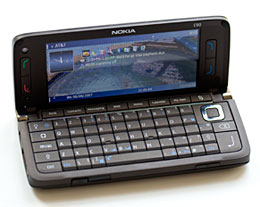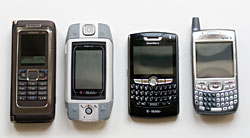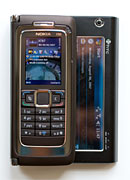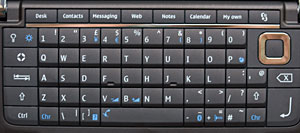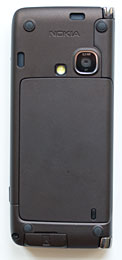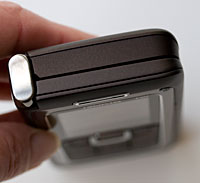
|
||||||||||||||||
Though the keyboard is relatively wide, it's not a good candidate for touch typing. The keys are much too stiff, there's no spacing and it's still not quite wide enough for average hands. Two-finger typing is fine, though we'd prefer to expend less energy pressing down a key. We found our typing speed to be just a bit faster than on the Nokia E62 and BlackBerry Curve, but not as fast as the HTC Advantage. The key surfaces have good traction and share the same finish as the phone's body, and there's a bevel line at the bottom of each key to help your fingers discern one row from the next. We like the very standard keyboard layout, with dual shift keys, tab key and large return key. There's a backlight on-off button for keyboard backlighting which is faint but adequate for quick typing in the dark. This button does double-duty to control screen brightness when you hold down the Chr key. The Chr key also gives you keyboard shortcuts to Bluetooth, IR, volume and Profiles. Commonly used characters and symbols such as @, slashes, dashes and = are easy to get to with a single press in most cases. Our APAC (Asia Pacific) region E90 had only English characters on the keyboard. The square d-pads, one to the right side of the keyboard and one on the outer cover, are nearly identical. The silver ring is the moving part, and is too narrow for quick navigation. The center action button on each is quite large and easy to press. The hinges are heavy duty and stiff, which means you can have the display stay open at most any angle up to 180 degrees flat, with a definite lock at about 5 degrees past the 45 mark. The smartphone's frame, battery door and hinges are made of metal, and the E90 feels and looks extremely well-made, if not built like the proverbial tank. Horsepower and Performance Low memory (RAM for running programs) has been a sore point for S60 smartphones since time immemorial. The E90 marks a wonderful step forward: instead of the 20 megs average, it has 80 megs free to run programs! In terms of Symbian applications, this means you can run many applications at once with no need to exit apps when memory gets low. Even RAM-hungry apps like Gallery, the web browser and Maps can all run together happily. This makes the E90 Communicator a serious business tool that can make the most of multi-tasking. We hope this is the beginning of a trend for Nokia, but we fear it might just be a bump for the Communicator line.
The Communicator runs on a dual core ARM11 family CPU at 332MHz and performance is very good by S60 standards. The E90 has dedicated 3D hardware acceleration which is an interesting inclusion for a business oriented phone. Likely it will be well-suited to run 2nd generation NGage platform games when they arrive. Video playback is quite good, with the phone handling 500kbps MPEG4 files with minimal frame dropping. The Nokia has 256 megs of NAND flash memory, with approximately 128 megs available for your use. Should you need more storage for music, videos or anything else, there's a hot swappable microSD card slot on the phone's left edge under a door. It supports the SDHC standard for cards over 2 gigs capacity. Phone Features, Reception and Data This is the first Communicator with 3G, and HSDPA at that. Sadly for us Americans, that high speed data connection is available only on the 2100Mhz band, which isn't used in the US. That means we have to resort to 2.5G EDGE, which averages 165k on the E90 according to DSL Reports mobile speed test. You can turn off 3G in phone settings to save power as a consolation. Thankfully, there's WiFi for much faster data when near a hotspot or home/work access point. The E90 is a quad band GSM world phone that supports all GSM bands: 850/900/1800/1900MHz and it's sold unlocked for use with any GSM carrier by Dynamism and other importers. The SIM card is located under the battery. Though import versions of the E90 aren't targeted to the US, the Nokia Settings Wizard had no trouble setting up AT&T and T-Mobile settings for data and MMS for us. Call quality was the usual excellent Nokia stuff, and reception is strong (stronger than the Nokia 9300) on both the 850 and 1900MHz bands as measured using PhoneNetInfo and other decibel-reading utilities. The E90 comes with the usual speed dial where you can assign 2 through 9 to numbers in your contacts (1 is reserved for voicemail). Also there is Nokia's voice dialing which we've never found very trustworthy (woe when it dials an overseas contact instead of the intended next door neighbor). Voice dialing gives you only 1.5 seconds to make sure it "heard" and dialed the correct number. We've extolled the many virtues of the S60 3rd edition web browser in several other reviews. Suffice to say it and the iPhone have the best browser in the mobile business, hands down. Pages are generally rendered faithfully, including javascript and most dHTML based on javascript, CSS, tables, frames and more. The S60 browser uses Safari technology, and it also handles WAP sites and RSS feeds. In conjunction with the 800 pixel wide screen display, it's a most desktop-like experience. Sorry, there's no QuickTime or Windows Media player but it does support Flash Lite, Real Media and multiple windows along with SSL. The Messaging application supports POP3 and IMAP email as well as SMS and MMS messages. If you leave the Messaging application running, it will automatically check for new mail and notify you (it retrieves headers only until you tell it to download the full message). It renders HTML emails quite well for POP3 and IMAP accounts. If you want BlackBerry Connect push email, you can download it from Nokia's Business software site here (it's free). Software The Communicator runs Symbian OS 9.2 with Nokia S60 3rd Edition Feature Pack 1. As mentioned, this is the first communicator to run S60, and overall the adaptation works well with good use of the added screen real estate. For example, Contacts has its listing on the left with the contact detail on the right. The calendar's default view shows the current month on the left, with appointments for the highlighted day shown on the right. Gallery has a scrollable list of media on the left and shows a preview size image on the right. The Communicator has both traditional notes that sync to Outlook and Active Notes which supports embedding images, business cards, sound and video clips. To-do items (tasks) are tracked in the calendar and all PIM applicatiions sync to Outlook under Windows and to the Mac OS X address book and iCal (no notes syncing though). PC Suite for Windows is included on the companion CD and you can download Nokia's iSync plugin for the Mac here. PC Suite allows you to transfer multimedia items including photos, music and videos under Windows and for Mac users there's a downloadable beta of Nokia Multimedia Transfer for syncing with iTunes and iPhoto. Calendar and Contacts are full-featured and up to business use with one continuing complaint: there's still no sort by company option in Contacts, truly odd for a business phone. For MS Office work there's QuickOffice which handles viewing and editing Word, Excel and PowerPoint files. It does a decent job of preserving formatting, and is as capable as the Mobile Office suite on Windows Mobile Professional (Pocket PC). The wide screen display is extremely well-suited to Excel document and PDF viewing. Adobe Reader handles PDFs, even long files with images and there's an un-zipping application as well along with the S60 File Manager. New is Nokia's Team Suite application, where you can creates teams for group messaging, conference calling and more. Fun and games include Nokia's Gallery application for viewing photos. There's a music player with playlists and EQ, Real Player that handles MP4 (including non-copy protected iTunes format MP4), MPEG4, 3GP, RA, AAC and RV files. In our tests, Real on the E90 had better than average performance for an S60 device, finally rivaling Windows Mobile Pocket PC devices with faster CPUs. There's also an FM radio that uses the wired headset as its antenna (though you can play radio through the speaker) and Flash Lite (not to be confused with the Flash browser plugin on the desktop). Music quality through the included stereo headset is very good, as it is through Bluetooth stereo headphones. GPS The E90 ships with software similar to the Nokia N95, which also has an internal GPS. The Communicator has a true GPS, though it's not a SiRF III which generally offers the best performance in mobile packages. Nokia Maps is a world-wide solution, and that's ambitious. While it's very cool to search for a restaurant called "Pescador" and see results not only nearby, but also in various states of Mexico along with Argentina and other countries; you know there have to be holes in mapping and navigation somewhere in the world. We hear Maps works fairly well in Europe, but in the US, it's a decidedly mixed bag.
Nokia includes a GPS application and Maps which provide mapping and navigation worldwide (turn-by-turn navigation and route simulation require a fee). The GPS application shows you current latitude, longitude, elevation, speed and more. The navigation and mapping are powered by Navteq and TeleAtlas and you can download maps to the phone (or microSD card) over-the-air or via WiFi. In addition you can use desktop map loader software to download and transfer maps to the phone. The on-phone software is actually smart2go which Nokia purchased, and it includes maps, an extensive POI database (points of interest), route simulation, directions shown both on map and turn-by-turn and more. It has day and night display modes and options to exclude toll roads, tunnels, highways and ferries. The software and basic service are free, but you must pay a monthly fee of approximately $13, or $110 for 3 years (for the US and Canada) if you want route simulation and turn-by-turn directions including spoken directions. Though maps and POIs are free for those areas of the world covered, you would have to buy navigation on a per country basis. So if you are a US resident but travel to France and want turn-by-turn navigation for France, you'll need to purchase that (which makes the 7 day and one month options attractive). Like the Nokia N95, the E90 is relatively slow to acquire a GPS fix and there's no assisted GPS feature to speed things up (yet). Our E90 takes between 1 and 2 minutes to get a fix, unless it's been used within the last hour, then it takes only 30 seconds to a minute. Unlike recent SiRF III GPS equipped PDAs and smartphones, the E90 isn't likely to get a signal indoors and can occasionally lose track of satellites for 10 to 30 seconds in a moving car with modest cloud coverage overhead. We really liked the logical and very complete POI listing, but were surprised that some businesses weren't available in the search function (i.e.: Apple Store-- there are 4 in our immediate area and other mapping/navigation solutions list them). Spoken turn-by-turn directions are delivered in a clear male voice and the route simulation is a must if you want to double-check the route before heading out. Here in the Dallas metroplex, an amazingly orderly street grid is the norm, and buildings are relatively short which should make for good results. But we found that the application was slow to re-route when we chose a different route: it took about 2 minutes for it to stop insisting we make various U-turns rather than re-routing. Granted our map data doesn't download as quickly over EDGE as it would over 3G overseas, but nonetheless, good guidance logic would have started re-routing much sooner. Mapping a route from location A to B with the same options (fastest route, no avoidances) often yielded different routes-- odd. Route selection was sometimes downright peculiar, as we also noted on the N95. For a fastest route selection, it consistently wanted us to make our way through the twisty, low speed roads in our development rather than taking the short hop out to a major road. There aren't many professional mapping and navigation solutions for the E90 with US maps yet. We tried Wayfinder which doesn't have the built-in solutions rich set of features, and it did a better job of routing but had the same slow acquisition times and lost satellites in-route.
WiFi and Bluetooth As we'd expect of a strong business phone, the Communicator has WiFi 802.11b/g. Range was average by PDA and smartphone standards and connections were reliable. The phone supports open and encrypted networks along with WPA, and has an auto-scan feature that will look for access points within range (you can turn this feature off to avoid endless notifications in urban areas and to save battery power). The Nokia intelligently switches to a saved WiFi access point if available, rather than using GSM/3G data. The E90 has Bluetooth 2.0 +EDR with pretty much every profile supported. There's handsfree, headset, remote SIM (for car kits), HID (Nokia includes their Bluetooth keyboard driver), serial port, A2DP stereo, DUN and file transfer. We had no problem transferring files to and from our Windows and Mac machines and syncing over Bluetooth to our Mac Pro using Nokia's iSync plugin. We tested the Plantronics Pulsar 590A stereo bluetooth headset and the Plantronics Discovery 655, BlueAnt Z9 and Samsung WEP-200 Bluetooth headsets all of which worked well. Stereo sound through the Pulsar 590A was rich and full by Bluetooth standards, and we managed 25 feet range. Battery Life The E90 has surprisingly good battery life for a smartphone with a large display (make that 2 displays), GPS and triple wireless radios. The 1500 mAh Nokia BP-4L easily lasted us 3 days on a charge without serious multimedia use (just watching a few 5 minute short films and listening to MP3s for an hour a day). The WiFi radio uses power judiciously and as such it didn't bring the battery to its knees. We used WiFi about 30 minutes per day and turned off automatic access point discovery (both to save battery life and because we didn't really want to know about the myriad access points always in range wherever we went). Constant GPS use, say for a day on the road, will use up the battery more quickly and we'd suggest a car charger for road warriors. Though the GPS is more power-frugal than on other mobile phones we've tested, in fact impressively so, it won't last 8 hours of continuous use. Conclusion A fantastic update to the Communicator line that's more like a re-birth. While keeping the best of the Communicator line's inventive and practical ergonomics, the feature set has been raised to the sky. HSDPA will thrill Europeans and quad band EDGE means the phone will work fine in the US as well as anywhere else in the world GSM service is available. WiFi will keep you connected when near an access point and Nokia's Bluetooth implementation is as usual, excellent. The PIM applications are strong and the Office suite plus Acrobat Reader make for a good mobile office. The web browser is best in its class and the mail application is decent. BlackBerry users will appreciate BlackBerry Connect and the phone's overall stability is excellent. For the first time, we get good multimedia and an excellent camera in a Communicator, which means down times won't be dull. Pro: Fantastic wide screen display with 800 x 352 resolution that's very viewable outdoors. Very good camera, WiFi, Bluetooth and a GPS. Excellent Communicator design melds a mobile phone with a notebook. The E90 is extremely stable and reliable. Con: In the US, the GPS and Nokia Maps is a mixed bag. Nokia has improved on the N95's GPS with firmware updates, and we hope they do the same with the E90. Large by phone standards. No US 3G. The mobile office and strong PDA features feel a bit hobbled without a touch screen. Web site: www.nokia.com Price: est. $900 to $1,200 US (price will likely settle around $900 in a month or two) Where we got our unit: www.dynamism.com
| ||||||||||||||||
